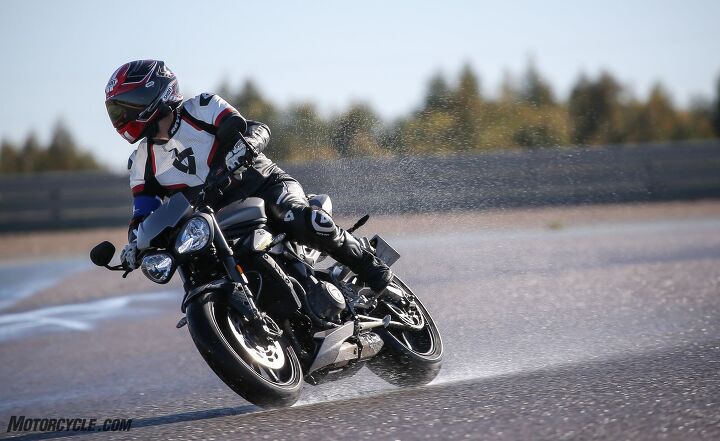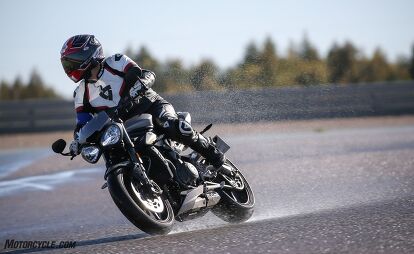New Rider: 5 Tips For Riding In The Rain

There's more to it than just staying dry
Maybe I’m not your typical motorcyclist because I absolutely love riding in the rain. I find that it heightens all my senses and can turn a mundane ride into one that becomes an intensely-focused experience. Perhaps my love of rain riding comes from the fact that, the very first time I commuted on a motorcycle, it rained – and I was prepared. (I was also terrified, but I’d only been riding for a few days.)
Still, many new (and experienced) riders won’t even consider riding when the rain comes down, and that’s really too bad. They’re missing out on what separates the weekend warriors from the hard-core motorcyclists.
If you’d like to improve your game in the wet, read on for some tips on how to ride proficiently when the skies open.
Riding in the rain:
1. Wear proper gear
It’s hard to have fun when you’re soaked to the bone. Plus, once you are good and wet, getting cold follows in relatively short order. Becoming hypothermic on a motorcycle is no joke. Your ability to concentrate and perform challenging mental tasks – like operating a motorcycle – is diminished. That’s before we even consider the creature comforts, like warm hands (that can actually manipulate controls).
At the bare minimum, you need a rain suit for inclement weather. It doesn’t need to be expensive, just sturdy, waterproof, and preferably brightly colored. My first rain suit only cost about $35 and was just a bright orange PVC-coated, one-piece jump suit I bought at an industrial supply store. It lasted me about a season. I also used a pair of pull-over rubber galoshes to keep my riding boots dry. They cost about $10. For gloves I used the largest dishwashing gloves I could find and wore them over my summer-weight riding gloves. These were nothing fancy, but they got me through my first year of riding motorcycles on the limited budget that I had at the time.
If you ride in a part of the country that experiences frequent rain, you might want to invest in some pricier rain gear that has venting and safety features like reflective striping. I’ve never understood why so many bikers insist on wearing black rain suits – they only make you harder to see in situations where visibility is already reduced.
When it comes to rain gear – or any motorcycle gear – buy the best gear you can afford, and it will last you many years.
2. Use smooth control inputs
Yes, traction is limited in the rain when compared to dry pavement, but the wet weather grip of motorcycle tires has made tremendous strides in the last couple of decades. Still, you shouldn’t go around making ham-fisted control inputs unless you want to end up on your head.
Smooth is the operative word, here. In order to give yourself time to be smooth with your control inputs, you’ll want to increase your following distance and lower your speeds.
Although ABS has transformed wet weather braking safety, you’ll stop quicker if you learn how to build braking pressure up to the point of lock-up when needed. An increased following distance gives you a little more time to apply your brakes and have the bike’s weight shift forward as you build in pressure. Abruptly applying the brakes in the rain will cause them to either immediately lock or have the ABS take over – neither of which are optimal braking techniques.
Smoothness is also key for cornering in the wet. Bend your bike into the turn. Don’t flick it. Choose more arcing lines rather than those with sharp turn in points if possible.
3. Pay attention to the pavement
The pavement surface can vary quite a bit as you travel down the road. In the rain, you should do your best to avoid paint and tar stripes. If you must go over them, try to be as upright as possible. The same goes for metal. Avoid manhole covers, metal plates covering construction, and railroad tracks like the plague! They can be as slick as ice if you try to turn or stop on them. If you absolutely must cross them, do so straight up and down while trying to avoid any steering, acceleration, or braking input.
At intersections, you should also do your best to avoid the center of the lane and, instead, stick to the car tire tracks. Any place that cars stop can accumulate oil drippings in the center of the lane while the tire tracks tend to be cleaner.
Be extra careful when crossing through puddles. Unless you can follow the tracks of a car immediately in front of you, you never know what lurks below the deceptively smooth surface of a puddle. It could be a huge pothole.
Once it stops raining, start looking for dry lines on the road. These will usually appear in the tire tracks first. In corners, look to the tire tracks on the outside of the turn.
4. Maintain your motorcycle
Proper maintenance of your machinery is important in every riding situation, but it plays a surprisingly big role in wet weather riding. Track your tire wear. When the wear bars begin to show, you will begin to have compromised traction in your tires if there is water on the road. The same is true of maintaining proper air pressure in your tires. Manufacturers design the tire tread to operate with a particular contact patch shape. If your tires are either over- or under-inflated, you’ll have less traction available because the grooves can’t channel the water away as effectively.
Believe it or not, an improperly adjusted chain can also affect your available rear wheel grip. Excessive chain slack can abruptly transfer power to the rear wheel, causing it to break traction – something you don’t want to do when going around a corner.
5. Improve your vision
During rain, your vision is impaired by many factors. So, anything you can do to keep your vision clear is important. First, don’t wear a tinted visor. It’s already darker in the rain. Why further reduce the amount of light that reaches your eyes?
The build-up of water droplets on the exterior of your visor is one of the biggest impediments for your vision. Ironically, it is more of an issue in light rain (or mist coming off the vehicles in front of you) than in a more continuous rain. The reason being that the smaller droplets can build up more densely on your visor. At low, around-town speeds, the best remedy is to wipe your visor with your glove. Some waterproof gloves even feature a wiper blade built-in to a finger for this purpose. At highway speeds, briefly turning your head left and right will allow the air-flow to push the droplets off your visor.
If you live in an environment where it frequently rains, treat your visor with a hydrophobic fluid such as Rain-X. This can help minimize the amount of water that will attach itself to your visor.
The other major contributor to poor vision in the rain is fog on the inside of the visor. More and more helmets come with pins to accommodate Pinlock anti-fog insert lenses. They are well worth the approximately $39.00 they cost.
If there is not a Pinlock lens available for your helmet, you can treat the inside of your visor with an anti-fog coating. Cat Crap is a popular brand that can be found at many outdoor products retailers. Simply apply it to the visor interior and buff away the excess, and your fogging problems should be minimized.
If you follow these tips, you’ll find that riding in the rain is much more pleasurable. While you may not learn to love riding in the rain, you may find yourself parking your bike less when the weather report calls for something other than sunshine.

Like most of the best happenings in his life, Evans stumbled into his motojournalism career. While on his way to a planned life in academia, he applied for a job at a motorcycle magazine, thinking he’d get the opportunity to write some freelance articles. Instead, he was offered a full-time job in which he discovered he could actually get paid to ride other people’s motorcycles – and he’s never looked back. Over the 25 years he’s been in the motorcycle industry, Evans has written two books, 101 Sportbike Performance Projects and How to Modify Your Metric Cruiser, and has ridden just about every production motorcycle manufactured. Evans has a deep love of motorcycles and believes they are a force for good in the world.
More by Evans Brasfield







































Comments
Join the conversation
The other thing thats helps for anti fogging is neat shampoo, put a small amount on a soft cloth and apply it to the in side of the visor, then buff it off, do not use water or conditioner just shampoo. Try it, it works even on the inside of your windscreen in your car.
If I get caught in it I ride in it. Define rain. As long as it's not a torrential downpour it isn't too bad, but I'm not going to watch the weather report and then go ride when heavy thunderstorms are predicted. I'd probably have the endorsement taken off my license with that attitude.